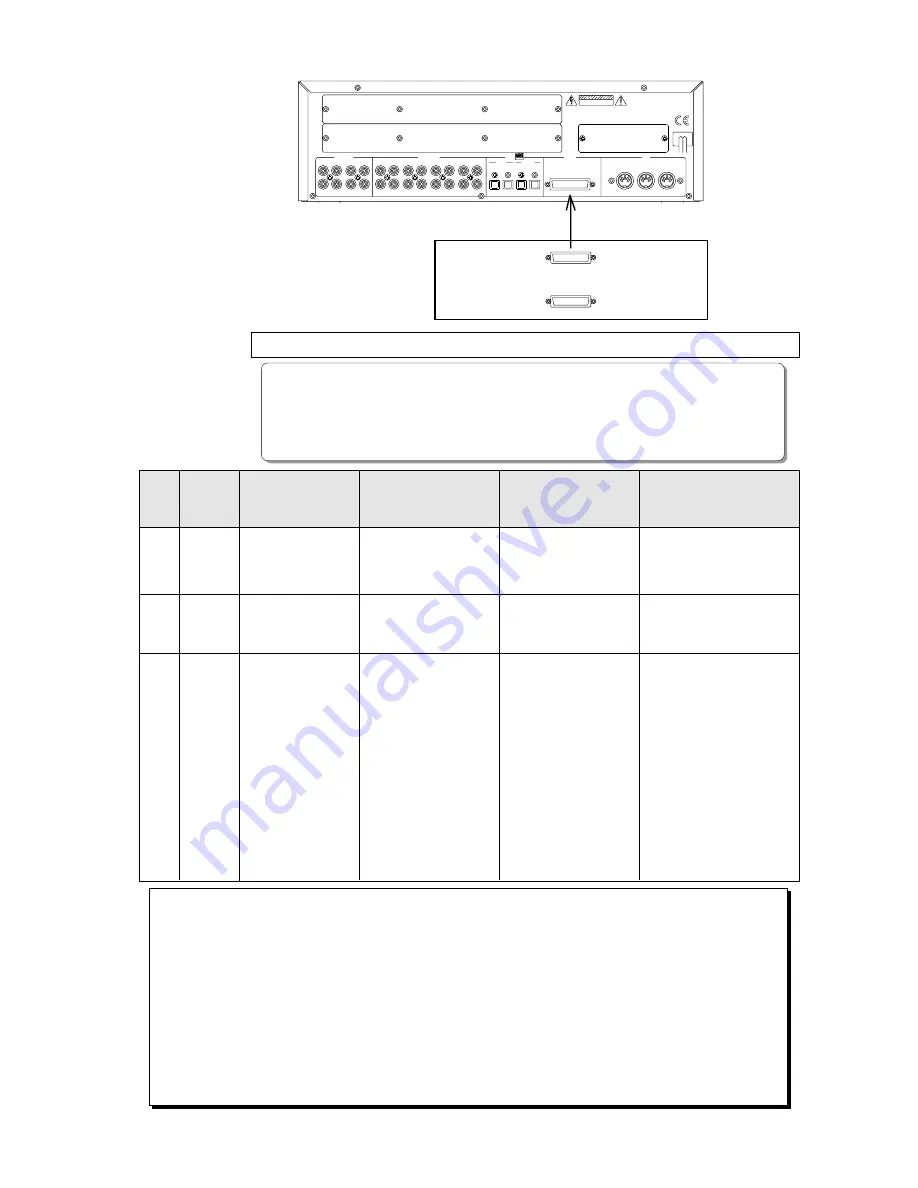
D-160 Owner's Manual (Saving and loading data)
109
D-160
External SCSI Equipment
Formatting a SCSI disk
About formatting a SCSI disk:
You will format a SCSI disk in the “Disk Format?” menu in Setup mode.
During formatting, the D-160 automatically checks the performance of the connected SCSI
device, selects and displays an appropriate format type from TYPE 0 - TYPE 2 (TYPE 2 is
selected as a default setting). The user can manually select the desired type.
TYPE
Remarks
SAVE/LOAD
It takes the same time to save
and load data using
TYPE 0 and TYPE 2.
TYPE 0
<Possible>
TYPE 2
<Possible>
TYPE 3
<Longest>
Depends on
the disk.
<Possible>
TYPE 3 is used to perform
simple formatting. Read the
notes below before proceeding
with the operation.
<Notes>
* TYPE 3 format will format the
disk, assuming that the entire
area in the disk is available, and
will not be able to identify the
area actually available.
* Bad blocks in the disk cannot
be selected. This may later
cause the sound to skip.
<Not possible>
The D-160 will reject any attempt to
set it in recording mode.
The degree of sound skipping will
depend on the result of automatic
measurement with TYPE 0 and 2.
TYPE 0: Skip -> less
TYPE 2: Skip -> frequent
The merit of TYPE 3 is that a shorter
formatting time is required, compared to
TYPEs 0 and 2.
For example, if you are using an MO disk
that has already been formatted for DOS
or MAC, usually there are no bad blocks
on the disk. Using TYPE 3 format will be
quicker than TYPEs 0 and 2.
The D-160 will not select this type using
the measuring function. Only users can
specify this type.
<Notes on real time recording and playback>
Logically, you can perform real time recording/playback if your case is described under the <Possible> category in
the table shown on the above. However, the sound might skip, depending on the condition of the connected SCSI
drive disk.
The D-160 performs experimental reading and writing at two points on the disk to measure the performance of the
connected SCSI device, and based on the results, such as the response time of the disk, it will determine the format
type (TYPE 0-2). Therefore, for parts of the disk other than the two measured points, you do not know if the disk
will maintain adequate speed to realize real time recording/playback.
It might be possible that the sound skips during real time recording or playback within the untested parts.
Measuring two points for performance can indicate tell whether or not the disk is reliable, but this is only an
“index.” Fostex will not guarantee the operation of the SCSI disk.
Available
recording
time
Real time recording
You need to select the SCSI drive
as the current drive.
Real time playback
You need to select the SCSI drive
as the current drive.
<Short>
Depends on
the disk.
<Long>
Depends on
the disk.
<Possible>
However, Fostex will not guarantee
the operation. Refer to "Notes on
real time recording/playback" for
more information.
<Possible>
However, Fostex will not guarantee
the operation. Refer to "Notes on
real time recording/playback" for
more information.
<Possible but the sound will skip>
<Not possible>
The D-160 will reject any attempt to
set it in recording mode.
We recommended that you use TYPE 2
format if you are using a SCSI drive only
to save and load data.
You cannot specify TYPE 0.
The measuring function of the D-160 will
select this option.
9
10
11
12
13
14
15
5
6
7
8
16
1
2
3
4
5
6
7
8
1
2
9~16
1~8
9~6
DATA
OUTPUT
INPUT
1~8
OPTICAL
INPUT
OUTPUT
THRU
ANALOG IN
ANALOG OUT
SCSI
MIDI
TO RAIN OR MOISTURE.
SHOCK. DO NOT EXPOSE THIS EQUIPMENT
TO REDUCE THE RISK OF FIRE OR ELECTRIC
WARNING:
NE PAS OUVRIR
:RISQUE DE CHOC ELECTRIQUE
AVIS
DO NOT OPEN
RISK OF ELECTRIC SHOCK
CAUTION
4
3






























